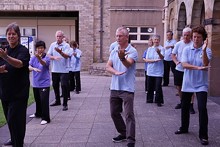Guide to Using the Tai Chi for Back Pain DVD
| By: Dr Paul Lam |
|
Copyright Dr Paul Lam 2005. Copying for non-profit educational purpose is permitted. For example, you may give your fee-paying students a copy of this article but not sell it to them. Disclaimer: Persons involved in the writing of this article will not be held responsible in any way whatsoever for any injury or consequence that may arise as a result of following the instructions given in this article. Readers are advised to work with their health professionals before commencing these activities. Readers engaged in activities described in this article do so at their own risk.
 Introduction: Tai Chi for Back Pain is based on the Tai Chi for Arthritis program. It is designed not just for people with back pain, also those are wheelchair bound and with other chronic conditions. Even for people with chronic fatigue syndrome could use this program. click here for a guide. The Tai Chi for Arthritis handbook is helpful together with the Tai Chi for Arthritis online lessons or DVD in learning this program. NB: The Tai Chi for Back Pain is now incorporated and taught from the Tai Chi for Arthritis program. Schedule a regular time per day pending on what your conditions allows you to, say half an hour to one hour daily and adhere to it as much as you can. Following a routine daily practice will help adhere to the practice. It is the best way to benefit and enjoy tai chi. If you can only do a half hour lesson, then split your lesson into two sessions. If you find the lesson covers too much material for you, then do them with as many sessions as is comfortable for you. It’s not how fast you learn tai chi that matters. Gaining health benefits and enjoyment came from regular practice and understanding the depth of tai chi. Be patient and take your time to learn and practice. You will develop your tai chi quicker and enjoy it more by taking time, it is tai chi dilemma, slower is quicker and less can be more. If you have a medical condition that prevents you from doing the forms exactly as shown on online lessons or the DVD, use visualization to keep progressing. The general rule: Move to what is well within your comfort zone and visualize whatever you can’t do. You can also adjust your level of exertion by not bending your knees too deeply. Let us start: 1. Start with the introduction. It explains what tai chi is and suggests general precautions. Take care to follow the precautions. The secret of tai chi’s near magical effect is the principles. They are based on the law of nature, Chinese Traditional Medicine and Martial art, over hundreds of years, they have been enriched and distilled to become seemingly simple, yet they are profound depth. Modern medical science has consistently reenforcing these principles. Regular practice will enable you to discover the many layers of depth to improve your tai chi. These principles are divided into three main categories.
The principles integrate with each other, for example, moving slowly will enhance mental quietness, and it would in turn improve Song. It is a good idea to focus on one principle for a while until you can incorporate it nicely into your tai chi forms, then move on to the next. By the time you work through all, you would be able to appreciate the deeper layer the next round. I been working on these principles for 45 years and still enjoy finding new depth and meanings. That is the attraction of tai chi. It is non-competitive and it is the journey that matters. It is a good idea to incorporate tai chi principles to our daily life when appropriate. For example in case of emergency, take a dan tian breathe and Jing the mind, then you would have a better chance to see the better ways to deal with it. Another example is to walk being mindful of weight transference, this will improve your balance and that is why tai chi is so effective at preventing fall. Go back to the online lessons and find the message at the end of each lessons. Each message shows you how to incorporate tai chi principles into the movements. Are you practising slowly, smoothly and continuously? Do you feel the gentle resistance? The more you think about principles the more you would enjoy and feel better about your tai chi. You will find that the fundamental principles in tai chi are similar in most tai chi texts and might appear simpler than they are. Regular practice will facilitate understanding and appreciating their depth. Through practice, you can learn and enjoy the different layers of tai chi’s inner meanings. Feel free to write to me for any advice or information. The best way to contact me is online at service@taichiforhealthinstitute.org Best wishes for a healthier and better quality of life. Enjoy the journey! Dr Paul Lam |



